wheel Hyundai Accent 2003 Owner's Manual
[x] Cancel search | Manufacturer: HYUNDAI, Model Year: 2003, Model line: Accent, Model: Hyundai Accent 2003Pages: 186, PDF Size: 11.36 MB
Page 39 of 186
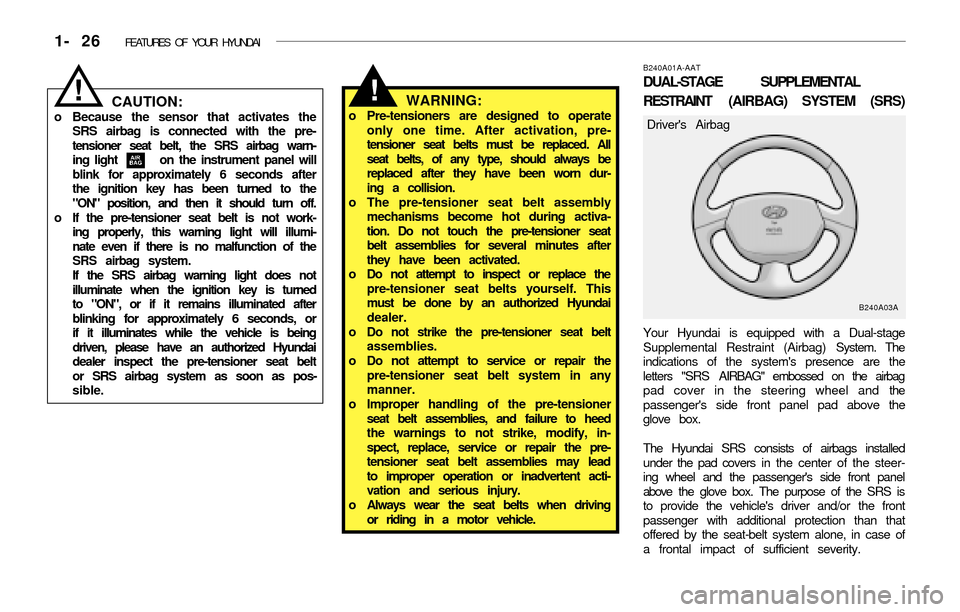
1- 26 FEATURES OF YOUR HYUNDAI
B240A01A-AAT
DUAL-STAGE SUPPLEMENTAL
RESTRAINT (AIRBAG) SYSTEM (SRS)
Your Hyundai is equipped with a Dual-stage
Supplemental Restraint (Airbag) System. The
indications of the system's presence are the
letters "SRS AIRBAG" embossed on the airbag
pad cover in the steering wheel and the
passenger's side front panel pad above the
glove box.
The Hyundai SRS consists of airbags installed
under the pad covers in the center of the steer-
ing wheel and the passenger's side front panel
above the glove box. The purpose of the SRS is
to provide the vehicle's driver and/or the front
passenger with additional protection than that
offered by the seat-belt system alone, in case of
a frontal impact of sufficient severity.
B240A03A
Driver's Airbag
WARNING:o Pre-tensioners are designed to operate
only one time. After activation, pre-
tensioner seat belts must be replaced. All
seat belts, of any type, should always be
replaced after they have been worn dur-
ing a collision.
o The pre-tensioner seat belt assembly
mechanisms become hot during activa-
tion. Do not touch the pre-tensioner seat
belt assemblies for several minutes after
they have been activated.
o Do not attempt to inspect or replace the
pre-tensioner seat belts yourself. This
must be done by an authorized Hyundai
dealer.
o Do not strike the pre-tensioner seat belt
assemblies.
o Do not attempt to service or repair the
pre-tensioner seat belt system in any
manner.
o Improper handling of the pre-tensioner
seat belt assemblies, and failure to heed
the warnings to not strike, modify, in-
spect, replace, service or repair the pre-
tensioner seat belt assemblies may lead
to improper operation or inadvertent acti-
vation and serious injury.
o Always wear the seat belts when driving
or riding in a motor vehicle.
!CAUTION:o Because the sensor that activates the
SRS airbag is connected with the pre-
tensioner seat belt, the SRS airbag warn-
ing light on the instrument panel will
blink for approximately 6 seconds after
the ignition key has been turned to the
"ON" position, and then it should turn off.
o If the pre-tensioner seat belt is not work-
ing properly, this warning light will illumi-
nate even if there is no malfunction of the
SRS airbag system.
If the SRS airbag warning light does not
illuminate when the ignition key is turned
to "ON", or if it remains illuminated after
blinking for approximately 6 seconds, or
if it illuminates while the vehicle is being
driven, please have an authorized Hyundai
dealer inspect the pre-tensioner seat belt
or SRS airbag system as soon as pos-
sible.
!
Page 40 of 186
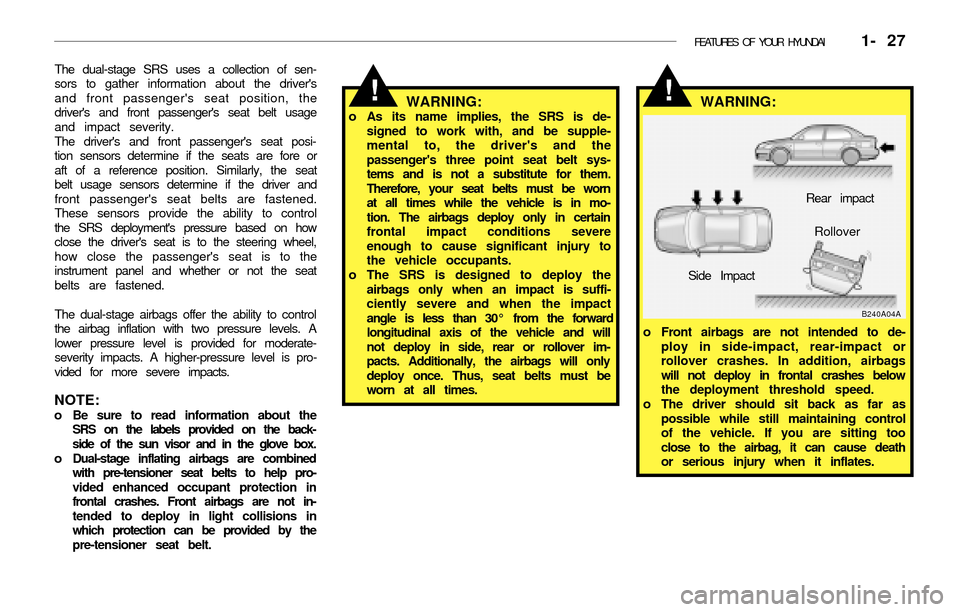
FEATURES OF YOUR HYUNDAI 1- 27
o Front airbags are not intended to de-
ploy in side-impact, rear-impact or
rollover crashes. In addition, airbags
will not deploy in frontal crashes below
the deployment threshold speed.
o The driver should sit back as far as
possible while still maintaining control
of the vehicle. If you are sitting too
close to the airbag, it can cause death
or serious injury when it inflates.
B240A04A
Rear impact
Side ImpactRollover
!
The dual-stage SRS uses a collection of sen-
sors to gather information about the driver's
and front passenger's seat position, the
driver's and front passenger's seat belt usage
and impact severity.
The driver's and front passenger's seat posi-
tion sensors determine if the seats are fore or
aft of a reference position. Similarly, the seat
belt usage sensors determine if the driver and
front passenger's seat belts are fastened.
These sensors provide the ability to control
the SRS deployment's pressure based on how
close the driver's seat is to the steering wheel,
how close the passenger's seat is to the
instrument panel and whether or not the seat
belts are fastened.
The dual-stage airbags offer the ability to control
the airbag inflation with two pressure levels. A
lower pressure level is provided for moderate-
severity impacts. A higher-pressure level is pro-
vided for more severe impacts.
NOTE:o Be sure to read information about the
SRS on the labels provided on the back-
side of the sun visor and in the glove box.
o Dual-stage inflating airbags are combined
with pre-tensioner seat belts to help pro-
vided enhanced occupant protection in
frontal crashes. Front airbags are not in-
tended to deploy in light collisions in
which protection can be provided by the
pre-tensioner seat belt.
WARNING:o As its name implies, the SRS is de-
signed to work with, and be supple-
mental to, the driver's and the
passenger's three point seat belt sys-
tems and is not a substitute for them.
Therefore, your seat belts must be worn
at all times while the vehicle is in mo-
tion. The airbags deploy only in certain
frontal impact conditions severe
enough to cause significant injury to
the vehicle occupants.
o The SRS is designed to deploy the
airbags only when an impact is suffi-
ciently severe and when the impact
angle is less than 30° from the forward
longitudinal axis of the vehicle and will
not deploy in side, rear or rollover im-
pacts. Additionally, the airbags will only
deploy once. Thus, seat belts must be
worn at all times.
!WARNING:
Page 41 of 186
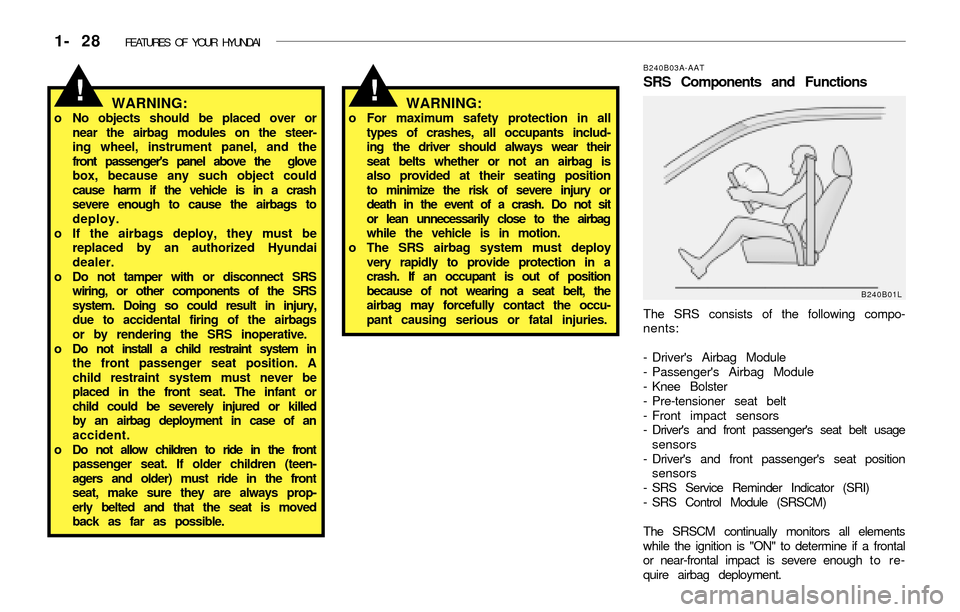
1- 28 FEATURES OF YOUR HYUNDAI
B240B03A-AAT
SRS Components and Functions
The SRS consists of the following compo-
nents:
- Driver's Airbag Module
- Passenger's Airbag Module
- Knee Bolster
- Pre-tensioner seat belt
- Front impact sensors
- Driver's and front passenger's seat belt usage
sensors
- Driver's and front passenger's seat position
sensors
- SRS Service Reminder Indicator (SRI)
- SRS Control Module (SRSCM)
The SRSCM continually monitors all elements
while the ignition is "ON" to determine if a frontal
or near-frontal impact is severe enough t o r e -
quire airbag deployment.
B240B01L
WARNING:o No objects should be placed over or
near the airbag modules on the steer-
ing wheel, instrument panel, and the
front passenger's panel above the glove
box, because any such object could
cause harm if the vehicle is in a crash
severe enough to cause the airbags to
deploy.
o If the airbags deploy, they must be
replaced by an authorized Hyundai
dealer.
o Do not tamper with or disconnect SRS
wiring, or other components of the SRS
system. Doing so could result in injury,
due to accidental firing of the airbags
or by rendering the SRS inoperative.
o Do not install a child restraint system in
the front passenger seat position. A
child restraint system must never be
placed in the front seat. The infant or
child could be severely injured or killed
by an airbag deployment in case of an
accident.
o Do not allow children to ride in the front
passenger seat. If older children (teen-
agers and older) must ride in the front
seat, make sure they are always prop-
erly belted and that the seat is moved
back as far as possible.WARNING:o For maximum safety protection in all
types of crashes, all occupants includ-
ing the driver should always wear their
seat belts whether or not an airbag is
also provided at their seating position
to minimize the risk of severe injury or
death in the event of a crash. Do not sit
or lean unnecessarily close to the airbag
while the vehicle is in motion.
o The SRS airbag system must deploy
very rapidly to provide protection in a
crash. If an occupant is out of position
because of not wearing a seat belt, the
airbag may forcefully contact the occu-
pant causing serious or fatal injuries.
!!
Page 42 of 186
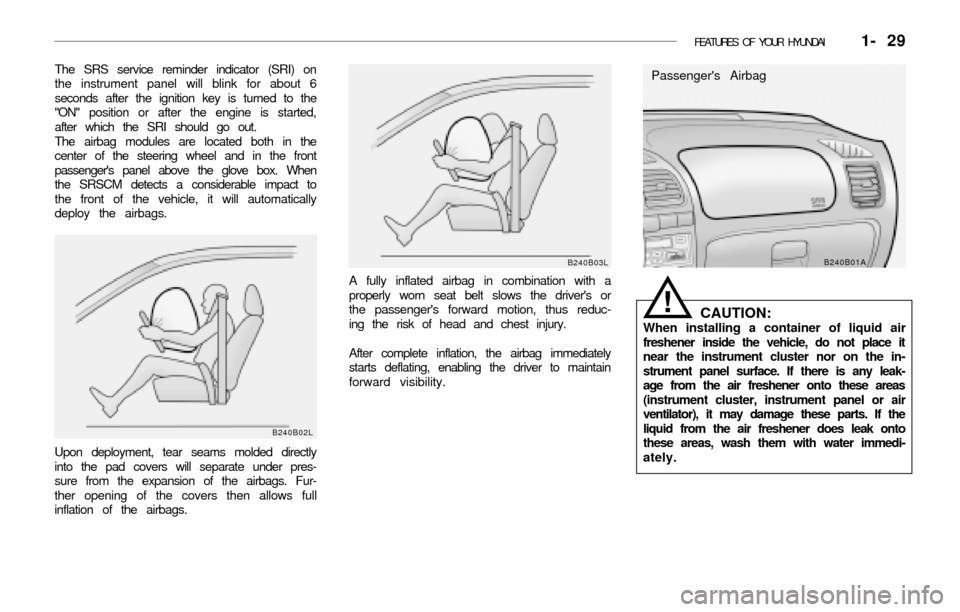
FEATURES OF YOUR HYUNDAI 1- 29
The SRS service reminder indicator (SRI) on
the instrument panel will blink for about 6
seconds after the ignition key is turned to the
"ON" position or after the engine is started,
after which the SRI should go out.
The airbag modules are located both in the
center of the steering wheel and in the front
passenger's panel above the glove box. When
the SRSCM detects a considerable impact to
the front of the vehicle, it will automatically
deploy the airbags.
A fully inflated airbag in combination with a
properly worn seat belt slows the driver's or
the passenger's forward motion, thus reduc-
ing the risk of head and chest injury.
After complete inflation, the airbag immediately
starts deflating, enabling the driver to maintain
forward visibility.
B240B02L
Upon deployment, tear seams molded directly
into the pad covers will separate under pres-
sure from the expansion of the airbags. Fur-
ther opening of the covers then allows full
inflation of the airbags.
B240B03L
CAUTION:When installing a container of liquid air
freshener inside the vehicle, do not place it
near the instrument cluster nor on the in-
strument panel surface. If there is any leak-
age from the air freshener onto these areas
(instrument cluster, instrument panel or air
ventilator), it may damage these parts. If the
liquid from the air freshener does leak onto
these areas, wash them with water immedi-
ately.
!
B240B01A
Passenger's Airbag
Page 44 of 186

FEATURES OF YOUR HYUNDAI 1- 31
!WARNING:o For best protection from the side im-
pact airbag system and to avoid being
injured by the deploying side impact
airbag, both front seat occupants
should sit in an upright position with
the seat belt properly fastened. The
driver's hands should be placed on the
steering wheel at the 9:00 and 3:00
o'clock positions.
The passenger's arms and hands should
be placed in their laps.
o Do not use any accessory seat covers.
o Use of seat covers could reduce or pre-
vent the effectiveness of the system.
o Do not install any accessories on the side
or near the side impact airbag.
o Do not use excessive force on the side of
the seat.
o Do not place any objects over the airbag
or between the airbag and yourself.
o Do not place any objects (an umbrella,
bag, etc.) between the front door and the
front seat. Such objects may become dan-
gerous projectiles and cause injury if the
supplemental side impact airbag inflates.
o To prevent unexpected deployment of the
side impact air bag that may result in
personal injury, avoid impact to the side
impact airbag sensor when the ignition
key is on.
HLC2036
Side airbag
sensor
WARNING:o The side impact airbag is supplemental to
the driver's and the passenger's three
point seat belt systems and is not a sub-
stitute for them. Therefore your seat belts
must be worn at all times while the ve-
hicle is in motion. The airbags deploy
only in certain side impact conditions
severe enough to cause significant injury
to the vehicle occupants.
!
B240C01A-AAT
SRS Care
o The SRS is virtually maintenance free and
there are no parts you can safely service by
yourself. The entire SRS system must be
inspected by an authorized Hyundai dealer
in 10 years after the date that the vehicle
was manufactured.
o Any work on the SRS system, such as
removing, installing, repairing, or any work
on the steering wheel must be performed by
a qualified Hyundai technician. Improper han-
dling of the airbag system may result in
serious personal injury.
HSM393
Page 45 of 186
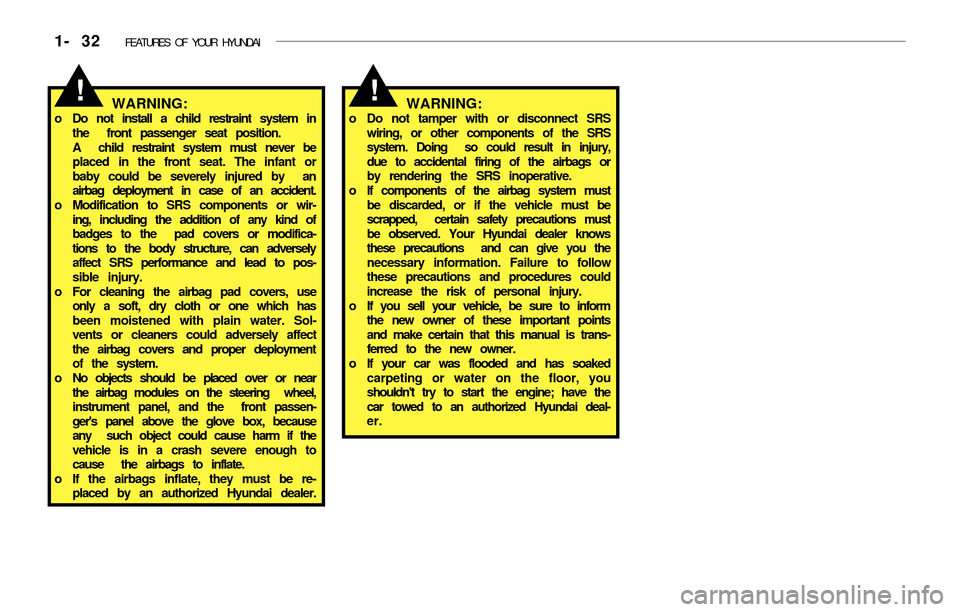
1- 32 FEATURES OF YOUR HYUNDAI
!WARNING:o Do not tamper with or disconnect SRS
wiring, or other components of the SRS
system. Doing so could result in injury,
due to accidental firing of the airbags or
by rendering the SRS inoperative.
o If components of the airbag system must
be discarded, or if the vehicle must be
scrapped, certain safety precautions must
be observed. Your Hyundai dealer knows
these precautions and can give you the
necessary information. Failure to follow
these precautions and procedures could
increase the risk of personal injury.
o If you sell your vehicle, be sure to inform
the new owner of these important points
and make certain that this manual is trans-
ferred to the new owner.
o If your car was flooded and has soaked
carpeting or water on the floor, you
shouldn't try to start the engine; have the
car towed to an authorized Hyundai deal-
er.WARNING:o Do not install a child restraint system in
the front passenger seat position.
A child restraint system must never be
placed in the front seat. The infant or
baby could be severely injured by an
airbag deployment in case of an accident.
o Modification to SRS components or wir-
ing, including the addition of any kind of
badges to the pad covers or modifica-
tions to the body structure, can adversely
affect SRS performance and lead to pos-
sible injury.
o For cleaning the airbag pad covers, use
only a soft, dry cloth or one which has
been moistened with plain water. Sol-
vents or cleaners could adversely affect
the airbag covers and proper deployment
of the system.
o No objects should be placed over or near
the airbag modules on the steering wheel,
instrument panel, and the front passen-
ger's panel above the glove box, because
any such object could cause harm if the
vehicle is in a crash severe enough to
cause the airbags to inflate.
o If the airbags inflate, they must be re-
placed by an authorized Hyundai dealer.
!
Page 48 of 186
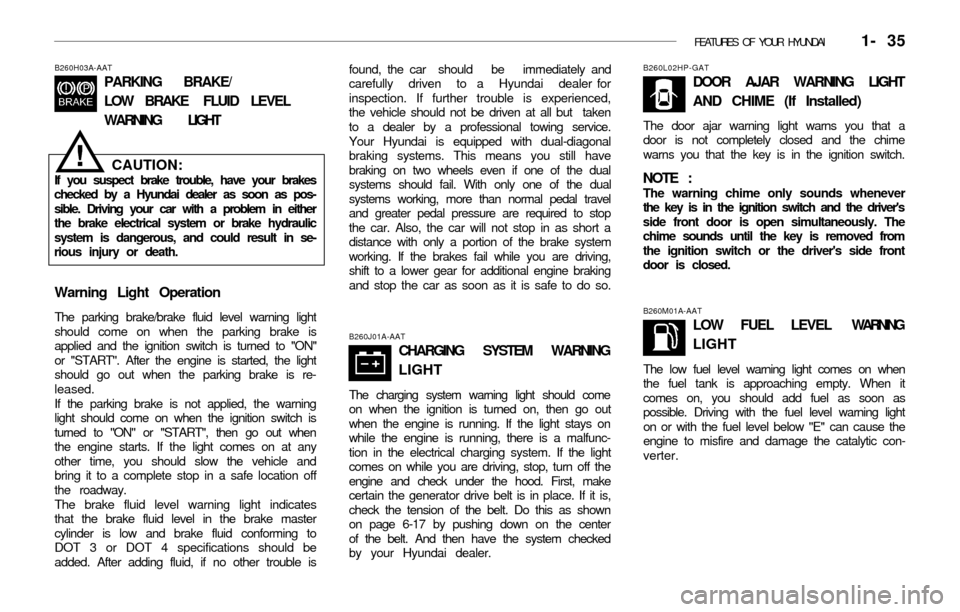
FEATURES OF YOUR HYUNDAI 1- 35
B260H03A-AAT
PARKING BRAKE/
LOW BRAKE FLUID LEVEL
WARNING LIGHT
CAUTION:
If you suspect brake trouble, have your brakes
checked by a Hyundai dealer as soon as pos-
sible. Driving your car with a problem in either
the brake electrical system or brake hydraulic
system is dangerous, and could result in se-
rious injury or death.
Warning Light Operation
The parking brake/brake fluid level warning light
should come on when the parking brake is
applied and the ignition switch is turned to "ON"
or "START". After the engine is started, the light
should go out when the parking brake is re-
leased.
If the parking brake is not applied, the warning
light should come on when the ignition switch is
turned to "ON" or "START", then go out when
the engine starts. If the light comes on at any
other time, you should slow the vehicle and
bring it to a complete stop in a safe location off
the roadway.
The brake fluid level warning light indicates
that the brake fluid level in the brake master
cylinder is low and brake fluid conforming to
DOT 3 or DOT 4 specifications should be
added. After adding fluid, if no other trouble is
!
B260J01A-AAT
CHARGING SYSTEM WARNING
LIGHT
The charging system warning light should come
on when the ignition is turned on, then go out
when the engine is running. If the light stays on
while the engine is running, there is a malfunc-
tion in the electrical charging system. If the light
comes on while you are driving, stop, turn off the
engine and check under the hood. First, make
certain the generator drive belt is in place. If it is,
check the tension of the belt. Do this as shown
on page 6-17 by pushing down on the center
of the belt. And then have the system checked
by your Hyundai dealer.
B260M01A-AAT
LOW FUEL LEVEL WARNING
LIGHT
The low fuel level warning light comes on when
the fuel tank is approaching empty. When it
comes on, you should add fuel as soon as
possible. Driving with the fuel level warning light
on or with the fuel level below "E" can cause the
engine to misfire and damage the catalytic con-
verter. found, the car should be immediately and
carefully driven to a Hyundai dealer for
inspection. If further trouble is experienced,
the vehicle should not be driven at all but taken
to a dealer by a professional towing service.
Your Hyundai is equipped with dual-diagonal
braking systems. This means you still have
braking on two wheels even if one of the dual
systems should fail. With only one of the dual
systems working, more than normal pedal travel
and greater pedal pressure are required to stop
the car. Also, the car will not stop in as short a
distance with only a portion of the brake system
working. If the brakes fail while you are driving,
shift to a lower gear for additional engine braking
and stop the car as soon as it is safe to do so.
B260L02HP-GAT
DOOR AJAR WARNING LIGHT
AND CHIME (If Installed)
The door ajar warning light warns you that a
door is not completely closed and the chime
warns you that the key is in the ignition switch.
NOTE :The warning chime only sounds whenever
the key is in the ignition switch and the driver's
side front door is open simultaneously. The
chime sounds until the key is removed from
the ignition switch or the driver's side front
door is closed.
Page 55 of 186
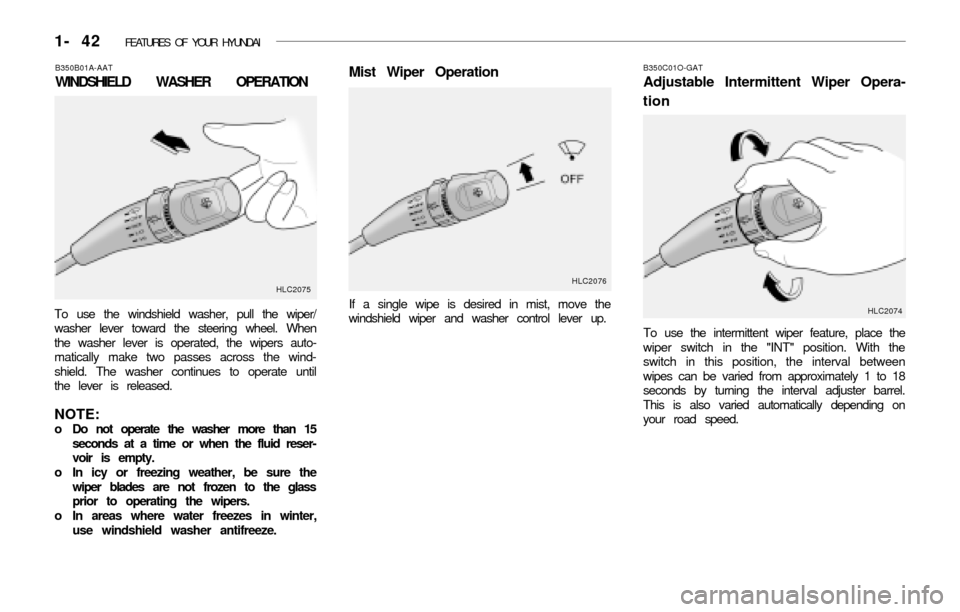
1- 42 FEATURES OF YOUR HYUNDAI
B350B01A-AAT
WINDSHIELD WASHER OPERATION
To use the windshield washer, pull the wiper/
washer lever toward the steering wheel. When
the washer lever is operated, the wipers auto-
matically make two passes across the wind-
shield. The washer continues to operate until
the lever is released.
NOTE:o Do not operate the washer more than 15
seconds at a time or when the fluid reser-
voir is empty.
o In icy or freezing weather, be sure the
wiper blades are not frozen to the glass
prior to operating the wipers.
o In areas where water freezes in winter,
use windshield washer antifreeze.
HLC2075HLC2076
Mist Wiper OperationB350C01O-GAT
Adjustable Intermittent Wiper Opera-
tion
To use the intermittent wiper feature, place the
wiper switch in the "INT" position. With the
switch in this position, the interval between
wipes can be varied from approximately 1 to 18
seconds by turning the interval adjuster barrel.
This is also varied automatically depending on
your road speed.
HLC2074If a single wipe is desired in mist, move the
windshield wiper and washer control lever up.
Page 69 of 186
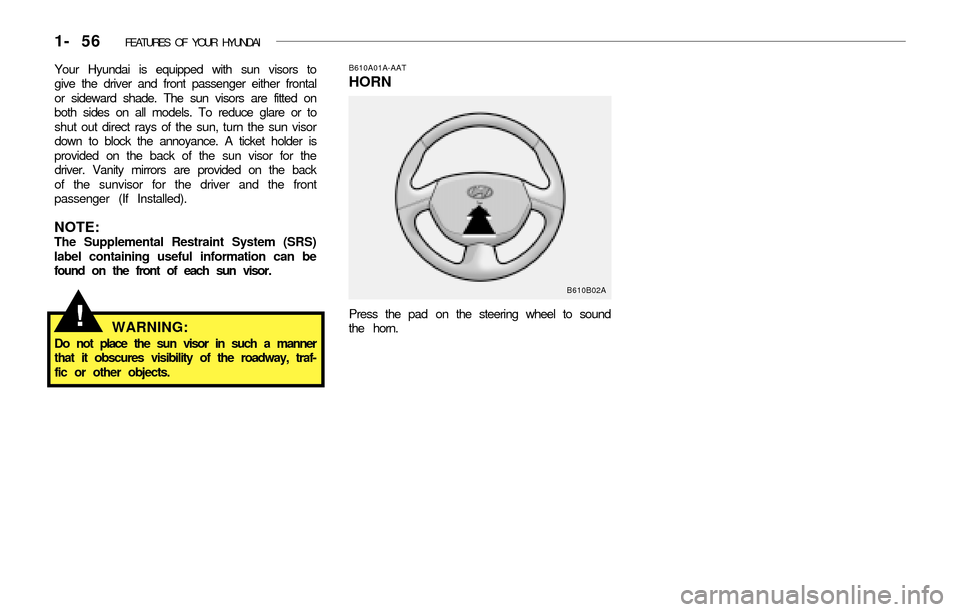
1- 56 FEATURES OF YOUR HYUNDAI
Your Hyundai is equipped with sun visors to
give the driver and front passenger either frontal
or sideward shade. The sun visors are fitted on
both sides on all models. To reduce glare or to
shut out direct rays of the sun, turn the sun visor
down to block the annoyance. A ticket holder is
provided on the back of the sun visor for the
driver. Vanity mirrors are provided on the back
of the sunvisor for the driver and the front
passenger (If Installed).
NOTE:The Supplemental Restraint System (SRS)
label containing useful information can be
found on the front of each sun visor.
!WARNING:Do not place the sun visor in such a manner
that it obscures visibility of the roadway, traf-
fic or other objects.
B610A01A-AAT
HORN
Press the pad on the steering wheel to sound
the horn.
B610B02A
Page 99 of 186
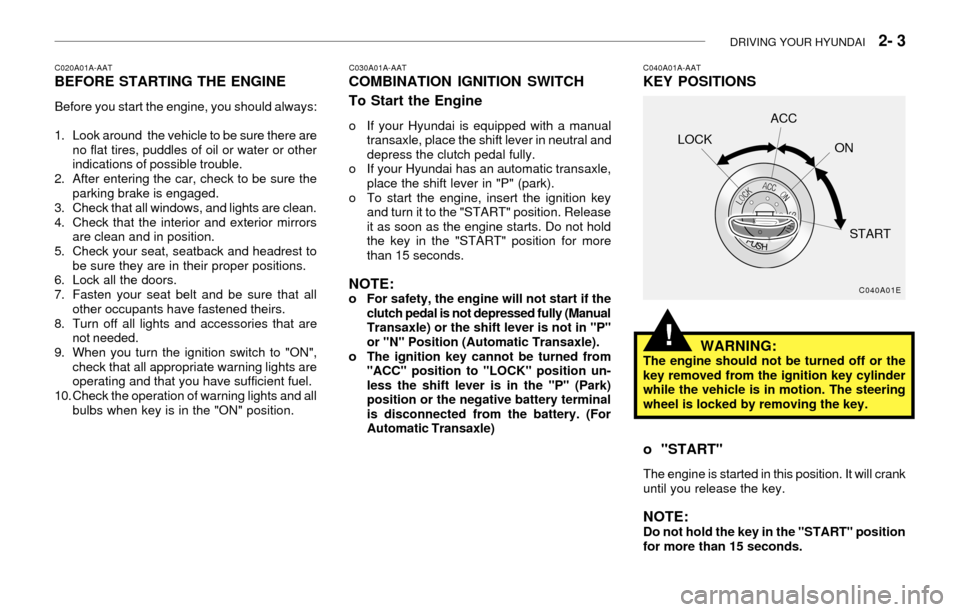
DRIVING YOUR HYUNDAI 2- 3
C020A01A-AATBEFORE STARTING THE ENGINE
Before you start the engine, you should always:
1. Look around the vehicle to be sure there are
no flat tires, puddles of oil or water or other
indications of possible trouble.
2. After entering the car, check to be sure the
parking brake is engaged.
3. Check that all windows, and lights are clean.
4. Check that the interior and exterior mirrors
are clean and in position.
5. Check your seat, seatback and headrest to
be sure they are in their proper positions.
6. Lock all the doors.
7. Fasten your seat belt and be sure that all
other occupants have fastened theirs.
8. Turn off all lights and accessories that are
not needed.
9. When you turn the ignition switch to "ON",
check that all appropriate warning lights are
operating and that you have sufficient fuel.
10. Check the operation of warning lights and all
bulbs when key is in the "ON" position.
C030A01A-AATCOMBINATION IGNITION SWITCH
To Start the Engine
o If your Hyundai is equipped with a manual
transaxle, place the shift lever in neutral and
depress the clutch pedal fully.
o If your Hyundai has an automatic transaxle,
place the shift lever in "P" (park).
o To start the engine, insert the ignition key
and turn it to the "START" position. Release
it as soon as the engine starts. Do not hold
the key in the "START" position for more
than 15 seconds.
NOTE:o For safety, the engine will not start if the
clutch pedal is not depressed fully (Manual
Transaxle) or the shift lever is not in "P"
or "N" Position (Automatic Transaxle).
o The ignition key cannot be turned from
"ACC" position to "LOCK" position un-
less the shift lever is in the "P" (Park)
position or the negative battery terminal
is disconnected from the battery. (For
Automatic Transaxle)
C040A01A-AATKEY POSITIONS
C040A01E
LOCKACC
ON
START
WARNING:The engine should not be turned off or the
key removed from the ignition key cylinder
while the vehicle is in motion. The steering
wheel is locked by removing the key.
o "START"
The engine is started in this position. It will crank
until you release the key.
NOTE:Do not hold the key in the "START" position
for more than 15 seconds.
!